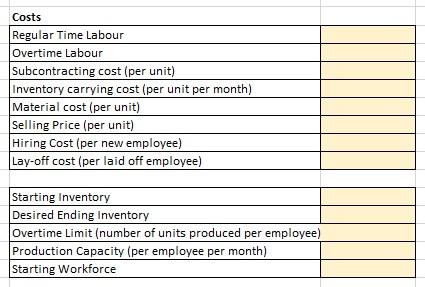Question
Question 1 Lavare, located in the Chicago suburbs, is a major manufacturer of stainless steel sinks. Lavare is in the middle of the demand and
Question 1
Lavare, located in the Chicago suburbs, is a major manufacturer of stainless steel sinks. Lavare is in the middle of the demand and supply planning exercise for the coming year. Anticipated monthly demand from distributors over the 12 months in shown in the table below.
Capacity at Lavare is governed by the number of machine operators it hires. The firm works 20 days a month, with a regular operating shift of eight hours per day. Any time beyond that is considered overtime. Regular-time pay is $15 per hour and overtime is $22 per hour. Overtime is limited to 20 hours per month per employee. The plant currently has 250 employees. Each sink requires two hours of labor input. It costs $3 to carry a sink in inventory for a month. Materials cost per sink is $40. Sinks are sold to distributors at a price of $125 each. We assume that no stockouts are allowed and the starting inventory entering January is 5,000 units and the desired ending inventory in December is also 5,000 units.
Market research has indicated that a promotion dropping prices by 1 percent in a given month will increase sales in that month by 20 percent and bring forward 10 percent demand from each of the following two months. Thus, a 1 percent drop in price in March increase sales in March by 3,000(=0.2 * 15,000) and shifts 1,800(=0.1 * 18,000) units in demand from April and 2,500(=0.1 * 25,000) units from May forward to March.
Table Anticipated Monthly Demand at Lavare
| Month | Demand Forecast |
| January | 10,000 |
| February | 11,000 |
| March | 16,000 |
| April | 19,000 |
| May | 22,000 |
| June | 25,000 |
| July | 31,000 |
| August | 28,000 |
| September | 22,000 |
| October | 19,000 |
| November | 13,000 |
| December | 12,000 |
Please put in all the columns in the excel file which are in the screenshots and fill in the columns. Show the solutions and the formulas used in the excel file. Do not use Excel Solver. If the screenshots are not clear, give me the access to attach the required excel file in chegg for your reference.
What is the optimal production plan for the year if we assume no promotions? What is the annual profit from this plan? What is the cost of this plan?





Step by Step Solution
There are 3 Steps involved in it
Step: 1

Get Instant Access to Expert-Tailored Solutions
See step-by-step solutions with expert insights and AI powered tools for academic success
Step: 2

Step: 3

Ace Your Homework with AI
Get the answers you need in no time with our AI-driven, step-by-step assistance
Get Started


